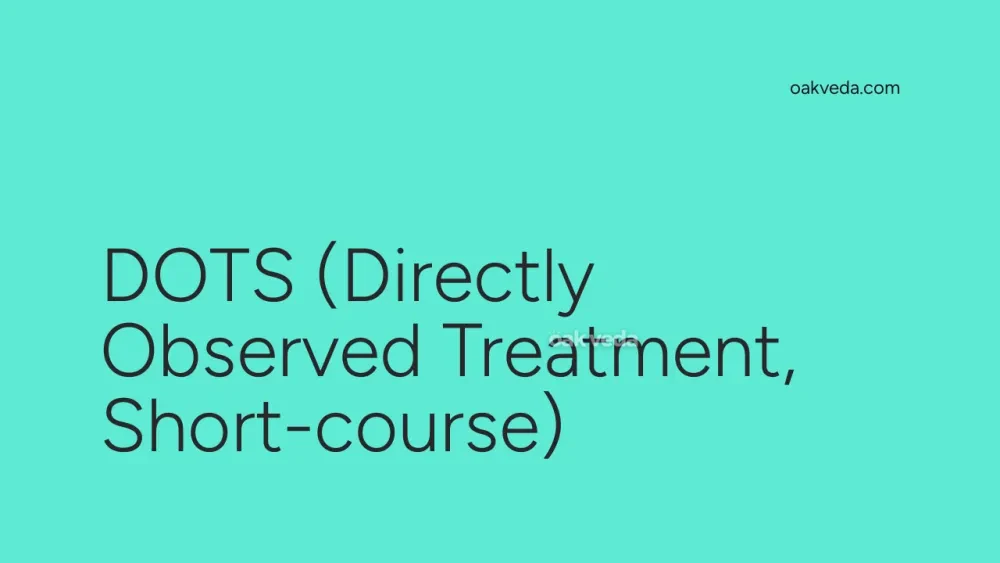
What is the Full Form of DOTS?
DOTS is the acronym for Directly Observed Treatment, Short-course. This term is widely used in the field of public health, particularly in the context of tuberculosis (TB) control and management.
What is Directly Observed Treatment, Short-course?
Directly Observed Treatment, Short-course (DOTS) is a comprehensive strategy recommended by the World Health Organization (WHO) for detecting and curing tuberculosis. It is a patient-centered approach to TB treatment that ensures patients take the right drugs, in the right doses, at the right intervals, under direct observation by a healthcare worker or a trained community volunteer.
Origin and Development of DOTS
The DOTS strategy was developed in the 1970s and 1980s, primarily based on research conducted by Karel Styblo of the International Union Against Tuberculosis and Lung Disease. The WHO officially adopted and promoted DOTS as a global TB control strategy in 1994. Since then, it has become a cornerstone of TB control programs worldwide.
How does DOTS work?
The DOTS strategy operates on five key components:
- Political commitment with increased and sustained financing
- Case detection through quality-assured bacteriology
- Standardized treatment with supervision and patient support
- An effective drug supply and management system
- Monitoring and evaluation system, and impact measurement
At its core, DOTS involves a healthcare worker or trained volunteer directly observing the patient swallowing their anti-TB medications. This ensures that patients complete their full course of treatment, which typically lasts six to eight months.
Functions of DOTS
The primary functions of the DOTS strategy include:
- Ensuring treatment adherence: By directly observing patients taking their medication, DOTS significantly improves treatment completion rates.
- Preventing drug resistance: Regular and complete treatment reduces the risk of developing drug-resistant TB strains.
- Reducing transmission: Effective treatment through DOTS helps in quickly rendering patients non-infectious, thereby reducing TB transmission in the community.
- Monitoring progress: DOTS allows healthcare providers to closely monitor patient progress and promptly address any side effects or complications.
- Providing patient support: The strategy includes educating patients about TB and offering support throughout the treatment process.
Applications of DOTS
While DOTS was initially developed for tuberculosis control, its principles have been applied to other health conditions requiring long-term treatment adherence, such as:
- HIV/AIDS treatment
- Management of chronic diseases like diabetes and hypertension
- Substance abuse treatment programs
Features of DOTS
Key features of the DOTS strategy include:
- Direct observation: A trained observer watches the patient swallow each dose of medication.
- Standardized treatment regimens: Use of WHO-recommended drug combinations and dosages.
- Regular follow-up: Patients are monitored throughout their treatment course.
- Free medication: In many countries, DOTS programs provide TB drugs free of charge to patients.
- Community involvement: Trained community members often serve as DOTS providers, making the strategy more accessible and culturally acceptable.
Benefits of DOTS
The implementation of DOTS has led to numerous benefits in TB control:
- Improved cure rates: DOTS has been shown to achieve cure rates of up to 95% even in the poorest countries.
- Reduced treatment default: Direct observation ensures patients complete their full course of treatment.
- Cost-effective: DOTS is one of the most cost-effective health interventions available.
- Decreased TB transmission: Effective treatment reduces the number of infectious cases in the community.
- Prevention of drug resistance: Proper treatment adherence helps prevent the development of multi-drug resistant TB (MDR-TB).
Limitations or Challenges of DOTS
Despite its success, DOTS faces several challenges:
- Resource intensity: Implementing DOTS requires significant human and financial resources.
- Patient privacy concerns: Some patients may feel that direct observation infringes on their privacy.
- Geographic barriers: In remote areas, daily direct observation can be logistically challenging.
- Cultural acceptability: In some cultures, the concept of direct observation may not be readily accepted.
- Healthcare worker shortages: Many countries face shortages of trained healthcare workers to implement DOTS effectively.
Future Developments in DOTS Technology
As technology advances, the future of DOTS is evolving:
- Video Observed Therapy (VOT): Using smartphones or computers for remote observation of medication intake.
- Smart pill bottles: Devices that record when the bottle is opened, potentially replacing direct human observation.
- Digital adherence technologies: Apps and devices that remind patients to take their medication and track adherence.
- Integration with telemedicine: Combining DOTS with telemedicine for remote patient monitoring and support.
FAQs on DOTS Full Form
-
Is DOTS only used for tuberculosis treatment? While DOTS was primarily developed for TB, its principles are now applied to other conditions requiring long-term treatment adherence.
-
How effective is DOTS in treating tuberculosis? DOTS has been highly effective, with cure rates of up to 95% reported in various settings.
-
Can family members serve as DOTS providers? Yes, in many cases, trained family members can serve as DOTS providers, making the strategy more convenient for patients.
-
Is DOTS mandatory for all TB patients? While highly recommended, the implementation of DOTS may vary depending on local health policies and patient circumstances.
-
How has DOTS impacted global TB control? DOTS has significantly contributed to reducing TB incidence and mortality rates worldwide since its introduction.
In conclusion, Directly Observed Treatment, Short-course (DOTS) has revolutionized tuberculosis control globally. By ensuring treatment adherence and providing comprehensive patient support, DOTS continues to play a crucial role in the fight against TB and serves as a model for managing other chronic health conditions.
You may be interested in:

